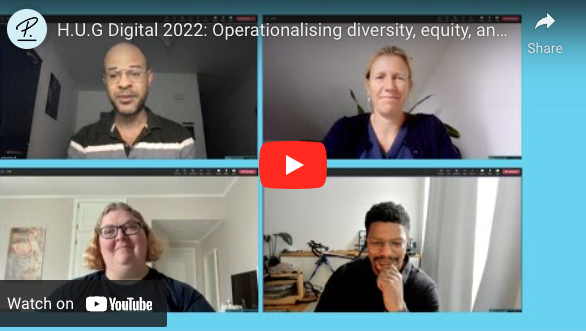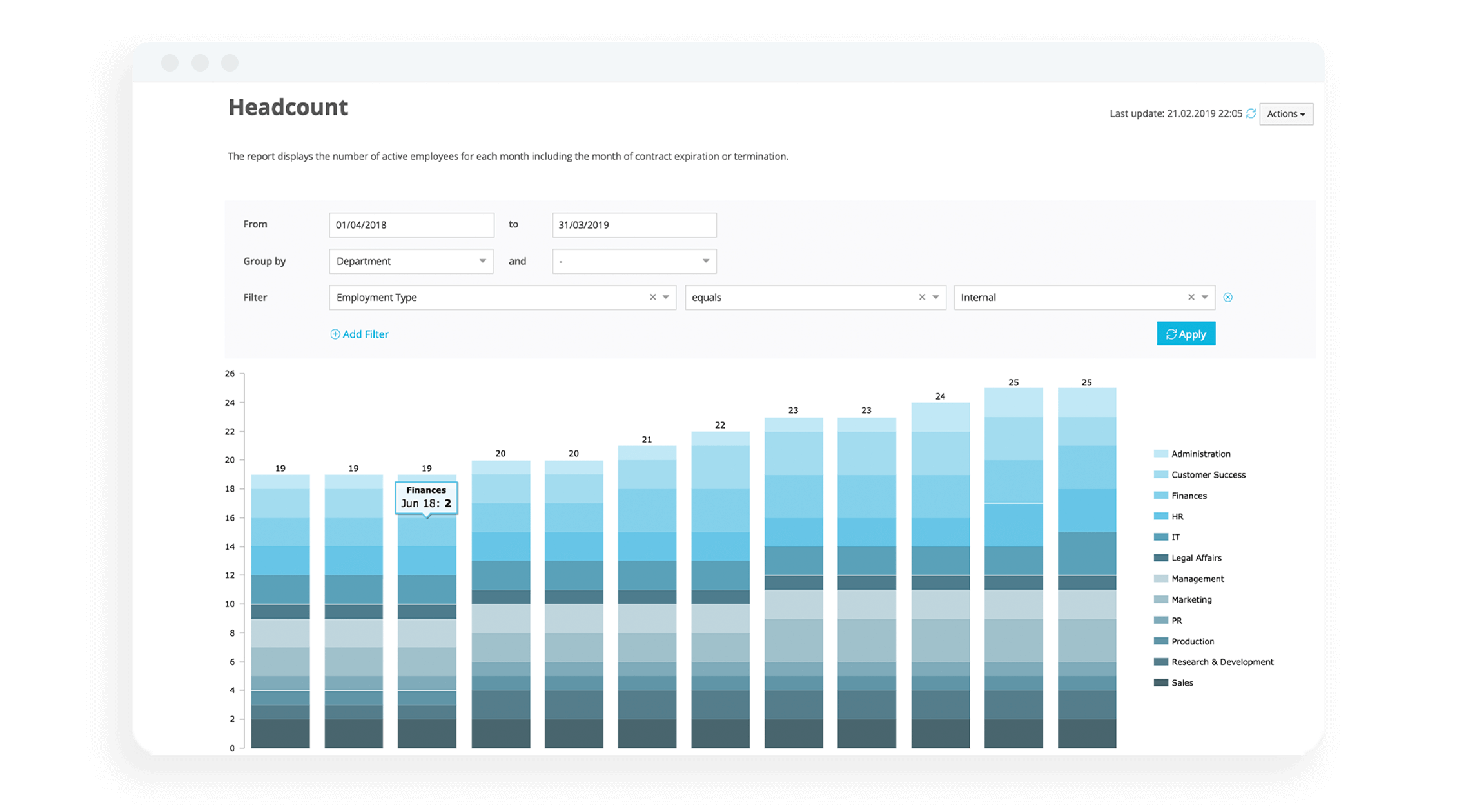Diversity Management: How Can It Help Grow Your Business?

Diversity management matters a great deal in modern workplaces. That's because equality and diversity in the workplace can lead tobetter functioning teams, happier employees, and, on top of that, more revenue. Even though it sounds like an HR manager’s dream, diversity management can turn it all into a reality.
How to drive a change in diversity: Download our Change Management guidelines here.What Is Diversity Management?
Diversity management, as part of HR management, is organisational action taken to promote the greater inclusion of employees across a variety of backgrounds. Its overall goal is to promote equality and diversity in the workplace through the social, cultural, and ethnic diversity of employees, by employing policies and strategies that are responsive to it.
What Is Diversity Management In The Workplace?
In the workplace, diversity management is a process of creating a working environment that is both diverse and inclusive. It values what every employee brings to the table as unique so that an organisation can grow and succeed accordingly. The overarching theory is that when employees come together from different backgrounds, creative problem-solving processes grow in turn.This is thanks in part to an increased amount of varying perspectives.
Is Diversity Management In The Workplace Important?
A diverse workplace can help organisations in a variety of ways. Mainly, it can serve as a reflection of a diversifying world — thanks to demographic changes, globalisation, and digitisation, workplace diversity can help teams become better attuned to the many needs of their customers.
Here are some of the key statistical takeaways, as per a study conducted by Glassdoor:
Ethnically diverse and inclusive companies are 33% more successful
1.7 times more likely to become innovation leaders in their field
Have better odds of attracting top talent, as 67% of job seekers care about diversity and inclusion
Watch: Operationalising Diversity, Equity and Inclusion From the Top Down
H.U.G 2022: Operationalising Diversity, Equity and Inclusion From the Top Down

We need your consent to load this service!
This content is not permitted to load due to trackers that are not disclosed to the visitor.
What is an Equality and Diversity Policy?
Many companies will employ an equality and diversity policy as part of their organisational makeup. It often discusses the importance of workplace diversity, and how companies will seek to live it in their policies, programs, and actions. Of course, the most important part of a document like this is ensuring you have the actions to match.
How Has Diversity Management Evolved?
Originally, diversity management was primarily about avoiding discrimination in recruitment and promoting tolerance within the company. But, over time and with multiple factors, things have evolved to where companies recognise the importance of diversity in the workplace as a key competitive advantage.
In order to show an in-depth understanding of a range of customers, a hiring policy geared toward diversity and inclusion pays dividends. That’s why companies such as Airbus, Porsche, Zeiss, and Volkswagen have long since put their faith in workplace diversity. In its Wolfsburg location alone, Volkswagen employs people from over 100 countries.
Instantly Analyse Your Workforce For Headcount, Diversity & More!

Personio offers a clear overview of KPIs and other analytics to make your HR more strategic and more data-driven than ever before. Discover automatic reporting with Personio today.
HR Analytics With Personio
How Should Diversity Management Be Structured?
As a rule, diversity management is integrated into a company’s HR or People function. However, some global corporations have whole teams or departments dedicated to it. These teams or employees typically help with some of the core tasks related to diversity management in the workplace, including:
Developing inclusive hiring plans and processes
Overall working policies that expand beyond simply hiring
Providing diversity training and learning opportunities for all employees
Playing the role of facilitator when it comes to communications
Encouraging interactions that help promote workplace diversity
Given the range of tasks, it’s understandable why diversity management often requires a team approach. For such a company-wide initiative, it’s crucial that diversity management is done right on every level of the business.
How Can Diversity Management Benefit Companies?
Here are some of the key benefits when it comes to workplace diversity benefiting companies:
Promoting an understanding of target groups from other cultures.
Ensuring improvements in customer service.
Driving innovative thinking in the company.
Boosting research and development.
Optimising decision-making processes thanks to different perspectives.
Establishing new business relationships and partnerships.
Opening up new markets.
But, diversity management and managing diversity, more broadly, does not only have a positive effect on the economic potential of a company. Businesses also benefit from genuine diversity in terms of their employees.
How Can Diversity Management Benefit HR?
HR departments also benefit from diversity in the workplace. When done right, it can lead to:
Greater employee satisfaction, because the team feels understood and valued.
An interesting and inspiring working environment for employees.
A positive company image that attracts top talent and high potential associates.
The enrichment of corporate culture.
Stronger employee loyalty to the company.
So, how can you take the importance of diversity management and make it real? Here’s how diversity management is implemented in a way to drive business…
Are There Types Of Diversity In The Workplace?
What exactly does a "diverse” team look like, though? Well, you certainly need to do more than just think about gender diversity every now and then in order to check the “diversity” box.
Rather, diversity becomes apparent in very different ways, for example through:
Internal factors: age, gender, education, ethnic origin, religion or belief, sexual orientation, and disability
External factors: income, education, work experience, marital status, parenthood, habits, leisure behaviour, and geographical location
How Do You Promote Diversity At Work?
For all intents and purposes, diversity management is the responsibility of HR. However, that does not mean that they can implement the process single-handedly.Just as the topic itself is characterised by integration and team spirit, HR managers need the help of influential partners to successfully establish a diversity-conscious approach.
Here are what teams and organisations can do to prepare for and promote workplace diversity…
1. Ensure Operational Readiness
Management, in particular, has a significant influence on whether diversity and inclusion are truly put into practice. First, make sure that the management team is ready to re-evaluate its corporate culture.
Only if the process is supported at the highest level and management principles take cultural diversity into account can your company successfully implement diversity management in the workplace.
In order to implement your HR diversity management practices, try and anchor your new values in concrete principles to ensure they are both present and measurable. Volkswagen, for example, has maintained its commitment to greater equality of opportunity and diversity within the company with its ‘TOGETHER Strategy 2025.’
Keep Your Employee Files Accurate, Always

Ensure all employee files are always up-to-date, organised, complete and data-compliant.
Get the checklist2. Identify Priorities and Goals
Before you decide, together with management, which diversity management initiatives make sense for your company, you should take a look at your corporate goals. Which skills are important to you? What helps you grow? And where are your problem areas?
Is the company’s rate of staff turnover above average? Then you should consider how you can improve the working atmosphere and hire and retain the right talent.
Do you find it hard to warm to international customers? If so, your priority should be to understand them better.
Is your product range hopelessly dull? In this case, multicultural workshops could help to boost your capacity for innovation.
3. Determine Initiatives
Now it is time to pull out all the stops. After determining how you expect your company to benefit from cultural diversity, you should create a plan of action. The initiatives themselves can take effect at a strategic level or be designed to be put into practice by the employees themselves.
What Are Actionable Workplace Diversity Initiatives Teams Can Take?
If you’re learning how to manage diversity in the workplace, you need to think about how to promote it. Let’s consider any one of these key initiatives as a starting point for HR departments:
Mentoring programs for employees
Management coaching on culture-specific topics
A culturally adapted advertising or communications strategy
Regular cross-departmental projects
Deploying an equal opportunity representative in the company
Offering language courses and language learning partnerships to break down language barriers
Actively combating stereotypes (for example, through awareness training)
Facilitating intercultural competence and conflict management
Restructuring existing recruitment processes to increase opportunities for equality
Offering a range of meal types in the company cafeteria (vegan, kosher, vegetarian, etc.)
Providing prayer rooms
Flexible working hour schedules
Child care services for employees with children
International cooking evenings
Senior- and disability-friendly workplaces
4. Allocate Roles
Make sure that areas of responsibility are clearly defined, both within and outside the HR department. For example, HR recruiters should be checking recruitment processes to ensure that job advertisements are formulated in a non-discriminatory way.
Language courses or the implementation of initiatives to encourage more management diversity are more in the competence area of HR development. In contrast, the creation of an equal opportunity representative position or the adaption of the company communications strategy are managerial tasks.
5. Monitor Results
Have your initiatives been productive? To find out, there are various indicators you can consider. For example, surveying satisfaction levels among employees and customers. Check the staff turnover rates. And take the temperature of the office:
What is the prevailing atmosphere?
Are ideas like shared cooking evenings attracting attention?
Do employees feel valued and understood?
What Are The Challenges In Managing Diversity At Work?
Although companies benefit from a diverse corporate culture, a very diverse range of employees working together also holds the potential for conflict. They are as follows:
Team-internal conflicts: When completely different perspectives and life experiences come together, a lot of tolerance, acceptance, and empathy are required. So, keep your eyes peeled: Is there any friction in the team? Power games? Maybe even signs of bullying? Make sure that employees have a contact person at all times in case of problems. Leaders should ensure transparency and openness within their teams and hold regular feedback meetings.
Cooperation conflicts: In India, work processes may well be very different than in Norway. And a 55-year-old will approach their duties differently than a 25-year-old. This can lead to communication problems in everyday interactions. HR managers should therefore ensure that employees share some common ground. This is something intercultural workshops and information events can help with.
The tokenism problem: Candidates recruited as part of diversity programs are sometimes perceived as underperforming or over-advantaged “token minorities.” This can lead to a focus on their gender, skin colour, or age rather than their abilities.
To avoid this, you should promote an open, transparent, and enlightened corporate culture and communicate clearly which specific abilities the person in question brings to the team.
Make sure that subconscious prejudices are exposed and diverse candidates are not seen as representatives of a minority, but rather as capable employees who enrich the company and its workforce.
How Do You Manage Diversity At Work?
We’ve already run through the importance of diversity in the workplace, but what are some of the key takeaways to ensure that you’re managing it effectively? Before we leave off today’s discussion, keep these five points in mind:
Diversity is not a buzzword, it is something you build every day and build it to last.
Create processes and policies from hiring to offboarding that promote diversity in all its forms.
Make other employees aware of diversity and how it exists as part of employee training.
Facilitate communication to help promote diversity and how it can lead to inspiring work environments.
Take time to focus on your culture and monitor results to make sure diversity is always in focus.
Keep these in mind as you focus on diversity management, and making workplace diversity a priority in your organisation. We wish you the best of luck!